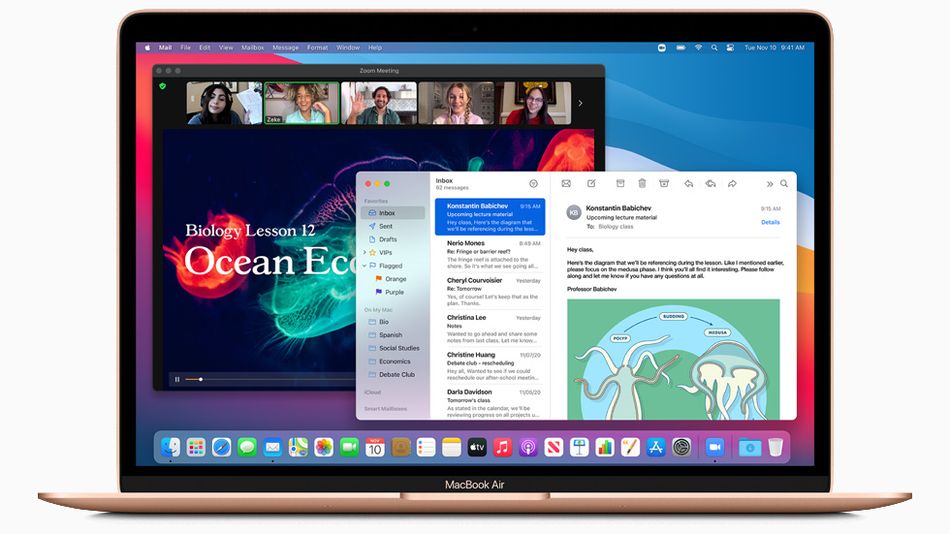
Image: Apple
Most of us are spending more time at home, which means we’re also spending more time on our (home) computers. So it’s extra important to make sure our devices are optimized and healthy. One of the easiest ways to do that is to improve your computer’s battery life.
MacBook users, read on to learn how to conserve battery life and maximize performance.
The general stuff
According to the Apple website, there are a few overall tips that can help improve the battery life of any Apple device. First, make sure all software is up to date. Check this by choosing System Preferences from the Apple menu in the left hand corner of your screen. In the preferences window, click Software Update (it’s the one that has concentric gears.) If there are any software updates available, the new software will be featured with a button next to it. Click the button to update.
Another thing to be mindful of is not exposing your device to extreme temperatures. The ideal temperature for your computer is between 62° and 72° Fahrenheit. For some devices, a protective case might generate extra heat, so make sure to take it off when charging.
Optimizing battery settings
When it comes to improving the battery life of MacBooks specifically, optimizing your settings is key to ensuring your device isn’t using up unnecessary power. To adjust these settings, first open System Preferences from the Apple menu. For MacBook users who have upgraded to the latest MacOS software version, which is 11.1 (Big Sur), these settings can be found by clicking on the Battery icon. For MacBook users who have not upgraded to Big Sur, the name for these settings is Energy Saver. The system preferences are essentially the same, and have the same capabilities, but the most recent system preference (Battery) has a few more features.


Now that you’re looking at the Battery/Energy Saver preferences, there are several settings you can change. Note: These are the options if you have Big Sur. Not all features will be on earlier OS versions, just as features from earlier versions won’t be on Big Sur — but this will get you started.
-
Turn off display after (a selected amount of time). Allows you to set the amount of time your computer display stays on before going to sleep. Set this to a short amount of time.
-
Slightly dim the display while on battery power. Automatically dims the brightness of your screen when your MacBook is unplugged. Check this box.
-
Enable Power Nap while on battery power. This feature checks for mail and updates while your MacBook is asleep. Uncheck this box.
-
Automatic graphics switching. Graphics mode is a type of high-resolution display that’s generally beneficial when you’re using your computer for something that requires high-res graphics, like gaming or photo/video editing. Since graphics mode can use up a lot of juice, this automatically turns it off when your computer is unplugged. Check this box.
-
Optimized battery charging. Keeping a computer plugged in and fully charged for extended periods of time can age the battery. This learns when you typically charge your computer and delays fully charging the battery until it knows you might soon be unplugging it. Check this box.

Adjust brightness
In addition to selecting a setting in which your MacBook automatically dims when it is unplugged, you can adjust the brightness manually on your keyboard by tapping the F1 key at the top of your keyboard. Brightness is one of the biggest uses of energy, so dimming your screen to a comfortable level will save a lot of battery.
Another light-related battery drain that you might not know about is your keyboard backlight. You can turn this off by going to System Preferences under the Apple menu, then Keyboard. There, you can choose to turn off your keyboard light, set it to turn off after a few seconds, or dim the brightness of the light.

Turn off/disconnect/close anything not in use
WiFi/Bluetooth
If you are in a situation where you don’t need WiFi or Bluetooth, make sure they are both turned off. Even if it’s not connected to a network, your WiFi and Bluetooth settings still consume power if they are on. You can do this by opening System Preferences under the Apple menu. To turn off WiFi, click Network. In Network settings, click the button that says “Turn Wi-Fi Off.” To turn off Bluetooth go to System Preferences and click Bluetooth. In Bluetooth settings, click the button that says “Turn Bluetooth Off.”
External hardware
Check for any SD cards, hard drives, etc. that are plugged in and disconnect them. To properly disconnect any external hardware open Finder, which is the smiling blue face icon at the bottom of your screen. If any external hardware is connected, its name will show up in the left hand column of the Finder window. Click the eject button next to the device’s name.
Also, Apple recommends plugging in your MacBook to a power source if you are charging other devices with (iPhone, iPad.) This might be obvious to some, but your computer’s battery will definitely drain faster if it is charging other devices.
Applications
Last but not least, close any applications you aren’t using. Certain apps, like the Chrome browser, can eat up a lot of energy, so if you’re trying to conserve battery life, consider using one that’s more energy-efficient like Safari. Spotify and Adobe programs are some other apps that drain battery.
Now, with your devices optimized, charged, and ready to go, the world is your oyster! And since this is still COVID times, by world we mean your living room, and by oyster we mean using your computer, unencumbered by the length of your charging cable.
